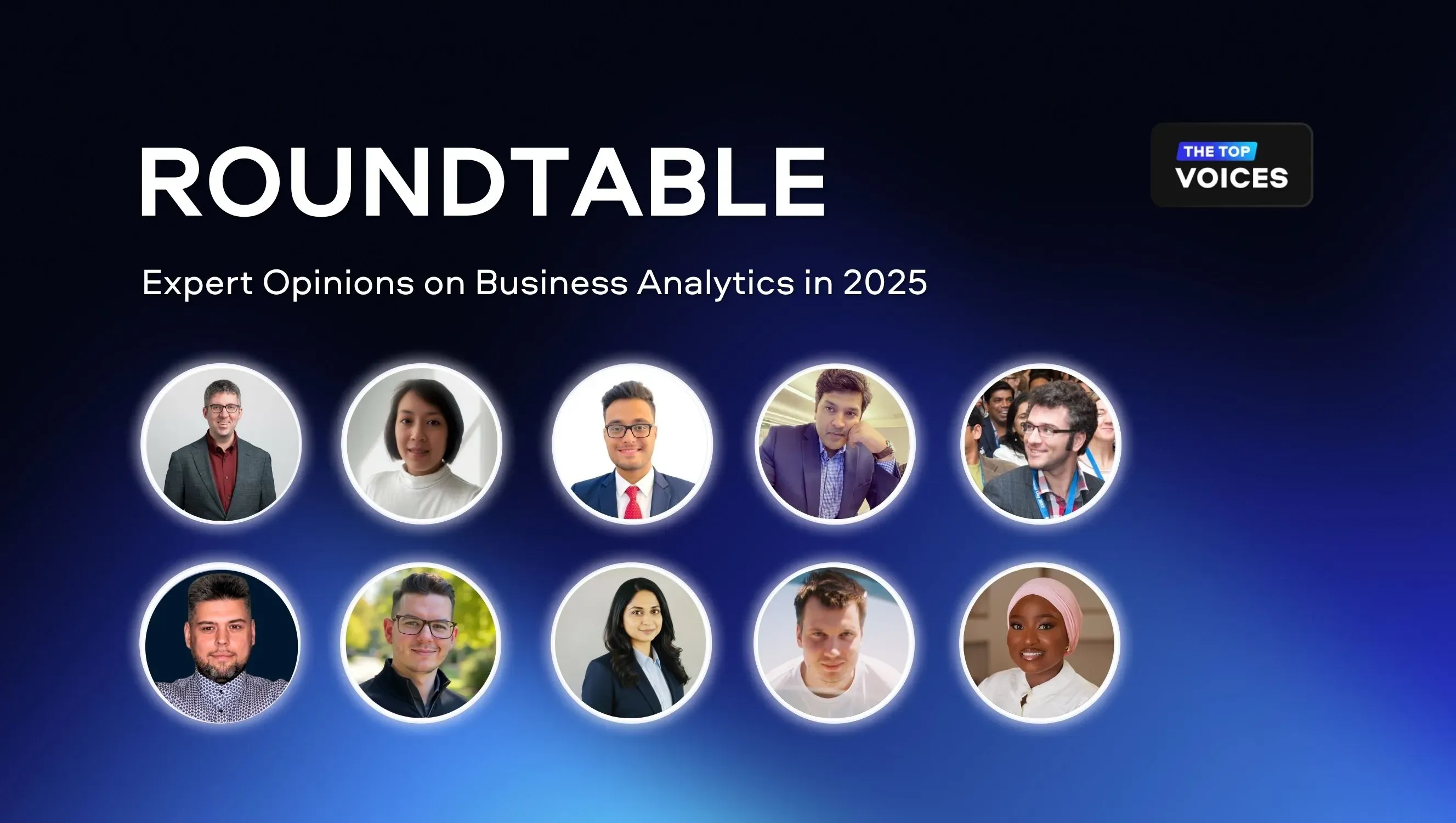Business analytics is rapidly transforming how companies understand their markets, make strategic decisions, and drive sustainable growth in 2025. To explore the key trends shaping this field, we’re hosting a roundtable discussion with top industry experts. During the session, speakers will share insights on emerging analytics tools, data-driven decision-making strategies, and how to turn insights into measurable business impact. Participants will leave with actionable takeaways on how to use analytics to strengthen operations, improve forecasting, and unlock new opportunities in the year ahead.
Our experts:
Chale Dodge, Practice Lead Business Analysis, Business Analyst Services Pty Ltd
Christina Tan, Principal Consultant & Chapter President, IIBA UK
Firoz Dalwai, Senior Business Analyst, Lucid Motors
Ibad Muhammad, Senior Business Analyst, City of New York
Igor Arkhipov, Founder, analystscorner.org and Business analysis manager, NAB
Iurii Gomon, Founder, Passionate Business Analyst
James Dean, Business Analyst, GridBeyond
Rimpy Sharma, Managing Director, KnowCloudAI
Roman Beseda, Head of Analytics, Yango
Sarumi Oluwatosin Saeedat, Business Analyst and Founder NexaCore Academy
Chale Dodge, Practice Lead Business Analysis

What are the key skills business analysts need today to bridge the gap between technical insights and strategic business outcomes?
Networking with purpose helps professionals remain both employed and employable — now and in the future.
There is an increasing demand for business analysts who can apply design thinking to simplify complexity and reduce the cognitive load on decision-makers. The goal is to make insights and recommendations clear and actionable — think concise one-pagers every time you present information to someone.
What are the most impactful new tools or technologies in business analytics that are helping companies move from raw data to actionable decisions in 2025?
In business analytics, there are a wide range of tools available, with the choice often depending on budget. For those seeking free options, Excel and KNIME are among the most effective.
Excel remains a leading choice due to its accessibility, familiarity, and flexibility. It supports advanced functionality through VBA and Python integration, and can be further enhanced when connected with Power BI for visualisation and reporting.
KNIME, on the other hand, is ideal for users looking to automate data workflows. It allows you to visually design, execute, and monitor each stage of the data process, making it an excellent option for repeatable analytics and process optimisation.
How do you see the role of AI and machine learning evolving in business analytics — will they replace traditional methods or complement them?
AI has long supported predictive analytics, but its true potential lies in its ability to evolve — to complete tasks and determine the next steps autonomously. Proactive thinking is becoming increasingly essential for AI, especially with the rise of a digital-first generation that expects data not only to be insightful but also actionable. The growing demand is for AI to make informed decisions on our behalf, ultimately enabling us to live more efficient and fulfilling lives.
Can you share a real-world example where analytics directly influenced a high-stakes business decision with measurable results?
I worked for a public sector organisation where data was manually imported into the system every four years to run key calculations. When the data was finally refreshed, it revealed a market uplift of $100 million AUD. This highlighted not only how outdated the data had become, but also the importance of regular data updates and incremental improvements in process efficiency.
Christina Tan, Principal Consultant & Chapter President, IIBA UK

What are the key skills business analysts need today to bridge the gap between technical insights and strategic business outcomes?
To effectively bridge the gap between technical insights and strategic business outcomes, today’s business analysts need to operate as translators, facilitators, and strategic enablers. I’d highlight five key skill areas that are critical in this space:
- Data fluency: we need to be able to interpret data, challenge assumptions, and extract insights that drive decisions. That means being comfortable with reporting and visualisation tools, but more importantly, knowing how to frame data in a way that resonates with stakeholders.
- Stakeholder engagement: The ability to navigate diverse stakeholder groups is essential. It’s about listening actively, asking the right questions, and translating technical complexity into business relevance. That’s where trust is built.
- Strategic and commercial awareness: A strong BA understands not just the immediate problem, but the broader business context, thinking beyond the requirements document and into the value proposition.
- Emerging tech literacy: As AI and automation become more embedded, BAs need to understand what’s possible, what’s ethical, and what’s scalable. I don’t need to build models myself, but I do need to assess feasibility, interpret outputs, and guide responsible adoption.
- Agile mindset: With the shift toward iterative and product-led delivery, BAs are embedded in cross-functional teams. I’ve worked closely with product owners and delivery leads to shape backlogs, refine user stories, and ensure that what gets built delivers measurable impact.
What are the most impactful new tools or technologies in business analytics that are helping companies move from raw data to actionable decisions in 2025?
From my perspective, one of the most impactful shifts is the rise of composable analytics platforms. Tools like Microsoft Fabric are enabling teams to embed live, AI-powered insights directly into operational workflows to enable decision intelligence being surfaced at the point of need.
Another game-changer is natural language querying. Tools like Power BI Copilot allow business users to ask questions in plain English and receive contextual, visual answers without needing technical expertise. That’s dramatically reducing the time from question to insight.
Looking ahead, I think we’ll see more convergence between AI agents and analytics, where autonomous agents not only surface insights but act on them within defined guardrails.
How do you see the role of AI and machine learning evolving in business analytics — will they replace traditional methods or complement them?
I see AI and machine learning as powerful enablers in business analytics, but not replacements for traditional methods. Their role is evolving rapidly towards driving predictive and even prescriptive insights, but the most effective outcomes still come from a complementary approach.
Traditional methods are still essential for context, nuance, and strategic alignment. AI excels at pattern recognition, anomaly detection, and scaling analysis across vast datasets, but it doesn’t inherently understand business priorities or human dynamics.
In my experience, the real value emerges when we combine both. For example, I’ve worked on programmes where machine learning models flagged unexpected trends in service usage, but it was through structured analysis that we uncovered the underlying drivers and shaped the right interventions.
So, rather than replacing traditional methods, AI is expanding the toolkit. It’s helping analysts move faster, ask better questions, and deliver more targeted recommendations, but always within a framework of human judgment, governance, and strategic intent.
Can you share a real-world example where analytics directly influenced a high-stakes business decision with measurable results?
One example that stands out is from a public sector transformation programme I supported, where analytics played a decisive role in reshaping a multi-million-pound service delivery model.
We were tasked with evaluating the performance of a legacy system used across several government departments. Initial stakeholder sentiment was mixed, and there was pressure to either upgrade or decommission the platform. Rather than rely on anecdotal feedback, we led a structured analytics initiative, pulling usage data, error rates, support ticket volumes, and cross-departmental engagement metrics.
What emerged was a clear pattern. While the system was under utilised in some areas, it was mission-critical in others, particularly where integration with external agencies was involved. We visualised this through heatmaps and service impact models, which helped senior stakeholders see not just where the system was failing, but where it was quietly enabling high-value outcomes.
As a result, the decision shifted from blanket decommissioning to a targeted reinvestment strategy. The measurable impact? A 40% reduction in support costs over 12 months, and a 25% increase in service uptime across the most critical functions.
It was a great example of how analytics, when framed with the right narrative, can move a conversation from opinion to evidence, and ultimately shape strategic investment decisions.
Firoz Dalwai, Senior Business Analyst

What are the key skills business analysts need today to bridge the gap between technical insights and strategic business outcomes?
Today’s business analysts must wear two hats — that of an analyst and a consultant. While technical expertise in tools like Tableau, SQL, and Python remains essential, the real differentiator lies in accurate data storytelling — the ability to communicate actionable insights that drive executive decisions. Analysts today need a hybrid mindset: analytical depth to extract meaningful patterns, and business acumen to connect those insights to revenue, customer experience, and operational efficiency.
Equally critical are collaboration and influence. Business analysts now operate as strategic partners, bridging data science teams and business leaders. The best analysts frame their insights in terms of impact, not just metrics, and use data to shape narratives that inspire action. In short, it’s no longer about simply “reporting the numbers,” but about owning the story behind them.
What are the most impactful new tools or technologies in business analytics that are helping companies move from raw data to actionable decisions in 2025?
In 2025, AI-powered and real-time analytics are transforming how businesses move from raw data to strategic action. Tools like Tableau and Power BI now embed machine learning and natural-language querying, allowing anyone to ask data questions conversationally and uncover insights instantly. Real-time analytics platforms are also enabling faster decisions by turning live operational data into immediate action points.
The biggest leap, however, comes from AI-driven decision intelligence — where large language models (LLMs) and predictive algorithms don’t just explain what happened but recommend what to do next. For business analysts, these innovations mean less time wrangling data and more time influencing outcomes.
How do you see the role of AI and machine learning evolving in business analytics — will they replace traditional methods or complement them?
AI and machine learning won’t replace traditional business analytics — they’ll amplify it. Traditional methods remain essential for defining hypotheses, understanding context, and validating insights. What AI adds is speed, scale, and predictive intelligence. Machine learning models can uncover hidden patterns, forecast outcomes, and automate repetitive analysis, allowing analysts to focus more on strategy and decision-making.
At Lucid Motors and across industries, AI is evolving from a back-end data science function to an integrated, everyday analytics companion — powering intelligent dashboards, natural-language queries, and real-time recommendations. The most successful organizations will be those where analysts combine human judgment with AI-driven insight — using technology not to replace thinking, but to elevate it.
Can you share a real-world example where analytics directly influenced a high-stakes business decision with measurable results?
One of the most impactful projects I worked on was building a Recruiter Ramp Model to help optimize hiring capacity and workforce planning. The model analyzed how long it takes for a recruiter to become fully ramped, how productivity evolves over time, and how many hires each recruiter can realistically deliver — factoring in offer decline rates, attrition, and recruiter efficiency by division.
By combining historical performance data and current open requisitions, we provided talent leaders with a data-backed view of recruiting capacity and hiring forecasts. These insights directly influenced headcount planning, budgeting, and recruiter staffing strategies. As a result, leadership could make more informed hiring commitments, reduce missed targets, and better align recruiting resources with business demand. This project highlighted how our people analytics function can turn complex workforce dynamics into clear, actionable strategy — aligning talent operations with business growth.
Ibad Muhammad, Senior Business Analyst

What are the key skills business analysts need today to bridge the gap between technical insights and strategic business outcomes?
A core competency for business analysts is the ability to translate strategic objectives into technology-enabled solutions that enhance end-user experience. This "conversion" refers to the implementation of functional capabilities that streamline business processes and align with desired outcomes. Analysts must also be adept at extracting and interpreting stored data to identify actionable patterns — patterns that can forecast results or prompt timely decisions by end users. Leveraging this predictive insight is essential for driving meaningful change and achieving positive business impact.
What are the most impactful new tools or technologies in business analytics that are helping companies move from raw data to actionable decisions in 2025?
Tools such as Tableau, IBM Cognos, and Power BI play a pivotal role in empowering end users to make informed decisions. By focusing on the reporting and visualization aspects of data, these platforms significantly enhance the accessibility and interpretability of complex information, driving strategic insights and operational efficiency.
How do you see the role of AI and machine learning evolving in business analytics — will they replace traditional methods or complement them?
Integrating these tools enhances traditional methodologies by introducing greater efficiency, reducing manual effort, and significantly accelerating decision-making processes. Their adoption streamlines operations and contributes to measurable time savings across business functions.
Can you share a real-world example where analytics directly influenced a high-stakes business decision with measurable results?
We’ve implemented data-driven analysis to support budget allocation for uniformed professionals who qualify for monetary benefits upon meeting defined eligibility criteria. However, under current legislation, end-user agencies retain the authority to legally override these criteria, granting eligibility to individuals who may not meet the original standards. This dynamic introduces variability that renders static, stored eligibility data insufficient for accurate forecasting. By leveraging pattern-based analytics — including override behavior — we now allocate budgets based not solely on anticipated eligibility, but on predictive models that account for historical override trends. This approach ensures more accurate financial planning and minimizes the need for reactive budget replenishment.
Igor Arkhipov, Founder, analystscorner.org and Business analysis manager

What are the key skills business analysts need today to bridge the gap between technical insights and strategic business outcomes?
To answer this question, we first need to define where the real gap lies. Arguably, it is in distinguishing valuable insights from noise and converting those insights into actions.
To bridge this gap, the foremost skill is analytical and critical thinking. The ability to see the bigger picture, identify meaningful connections, and resist being swayed by populism or industry buzzwords helps maintain focus on what truly matters and supports effective prioritisation.
Next is technological awareness of both the modern tools within the relevant industry and those that enhance personal productivity. Understanding what enabling technologies can and cannot do is just as important as identifying the best course of action based on insights.
Third comes communication and storytelling. Business analysis is, first and foremost, a people-centred profession, and effective business analysts must know how to connect with others on multiple levels. The ability to translate insights and strategy into stories that resonate with stakeholders on a personal level helps drive action and build trust.
Last but not least, as AI and automation continue to expand, ethical awareness becomes more and more crucial. Business analysts should take into account requirements for fairness, transparency, and inclusivity when defining or evaluating technical solutions.
What are the most impactful new tools or technologies in business analytics that are helping companies move from raw data to actionable decisions in 2025?
It would be hard not to mention the rise of generative AI and its application across various aspects of business and everyday life. While prone to errors and hidden biases, such tools are rapidly taking centre stage and will continue to shape this space in the years ahead.
We may be witnessing a shift from a data-driven world to a context-driven one where information is created, formatted, and stored in an AI-friendly manner to enable quick, on-the-fly, just-in-time analysis and presentation, rather than being pre-processed for a limited, pre-defined set of use cases.
How do you see the role of AI and machine learning evolving in business analytics — will they replace traditional methods or complement them?
I don’t think there is such a thing as a “traditional” method. Methods exist to achieve desired outcomes. What is business analytics really about? It’s about the ability to find answers to important questions. The main value a good analytics professional brings is not simply the ability to crunch numbers, but to distil and formulate meaningful questions and to devise effective methods to answer them.
AI tools can assist with both aspects. They can help spot patterns that point to areas requiring further investigation, and can co-design methods for uncovering the answers we seek. AI promises to stay, and it will undoubtedly continue to influence how we approach everyday challenges. It is likely to become a go-to partner for initiating and scoping analysis, not just for delivering final outcomes. I see these tools increasingly penetrating the early stages of work such as hypothesis generation and the formulation of research questions. This areas humans historically tackled alone. Now, we have a technological partner in AI.
With AI tools, we have greater freedom to experiment and prototype. The cost of piloting ideas is falling, and the barriers to entry are lower. We’re freer to ask questions and explore; and to unleash that five-year-old within us who constantly wonders "why". Once the right questions emerge, we can apply the analytical mindset of a data professional, now augmented by better tools that we have at our disposal today.
Can you share a real-world example where analytics directly influenced a high-stakes business decision with measurable results?
Analytics has long influenced decision-making across the board and continues to do so every day. From my experience in digital consulting, design decisions become significantly more impactful when they are supported by real data, such as results obtained through a series of experiments or A/B tests.
I’ve been involved in projects where individuals with strong opinions or senior titles dominated the decision-making process. In “soft” disciplines like experience design, such opinions are often shaped by personal preferences, matters of taste, or unconscious biases. Validating design decisions through experiments with clear metrics helped us create a structured framework for assessing ideas and distinguishing those that work from those that do not.
This approach keeps the focus on metrics that truly matter to the business (such as conversion rates, user error rates, customer support contacts, etc.) at the same time making it possible to clearly demonstrate the return on investment in design efforts.
Iurii Gomon, Founder, Passionate Business Analyst

What are the key skills business analysts need today to bridge the gap between technical insights and strategic business outcomes?
Business Analysts in BI must be proficient in ETL, SQL, Python, Power BI/Tableau to extract actionable insights from complex datasets and translate them into clear, business-focused recommendations. Equally important is strategic acumen - understanding how technical possibilities align with organizational goals and market trends. This ensures that analytical findings drive long-term value rather than just tactical improvements.
What are the most impactful new tools or technologies in business analytics that are helping companies move from raw data to actionable decisions in 2025?
I'd say, AI-driven agentic analytics. Tools like ThoughtSpot’s SpotIQ and Qlik Insight Advisor that leverage automated machine learning and natural language processing. Similarly, Connecty AI employs a semantic knowledge graph to translate plain-English prompts into optimized SQL queries against cloud data warehouses such as Snowflake and BigQuery. These platforms reduce reliance on data engineering teams by embedding AI-powered “data assistants” into self-service BI, enabling business users to ask strategic questions and receive precise, context-rich answers immediately.
How do you see the role of AI and machine learning evolving in business analytics — will they replace traditional methods or complement them?
AI and machine learning are increasingly complementing rather than replacing traditional business analytics methods. However, AI/ML layers are being integrated on top of these methods. For instance, unsupervised learning models can continuously scan transaction data to flag outliers that warrant human investigation, while supervised models forecast demand or churn with higher accuracy than rule-based heuristics. This synergy allows analysts to shift focus from routine data wrangling to value-added activities like hypothesis generation, scenario modeling, and strategic advising.
James Dean, Business Analyst

What are the key skills business analysts need today to bridge the gap between technical insights and strategic business outcomes?
The foundational role of the Business Analyst (BA) remains constant: to connect what's possible with what's valuable by bridging understanding and execution. This starts with clearly defining the business need (the problem or opportunity) and ensuring it aligns with the overall strategy. Effective analysis requires a holistic view across four levels: process, people, technology/systems, and data. This multi-level perspective ensures thorough requirements decomposition and adaptable analysis approaches. Furthermore, active communication, collaboration, and facilitation are essential to maintain alignment across diverse stakeholders, ensuring everyone agrees on the value to be delivered.
In the age of AI, the BA's core skills are more crucial than ever. While tools like Generative AI are valuable, BAs must adopt skills like prompt engineering to guide AI outputs, but crucially they must rely on their curiosity, analytical and critical thinking to challenge, verify, and validate all information, whether it comes from a stakeholder or an AI model. Finally, the BA must cultivate data literacy and storytelling skills. The smartest analysis is useless if it doesn't move the needle; the BA's job is to connect people and data so the insight is felt, not just heard. This combination of strategic alignment, critical challenge and adaptability is what allows BAs to turn insight into genuine impact.
What are the most impactful new tools or technologies in business analytics that are helping companies move from raw data to actionable decisions in 2025?
The shift toward transforming raw data into competitive advantage in 2025 is driven by technologies that prioritise speed and accessibility. Key among these are Generative AI (like ChatGPT or Microsoft Copilot) and agent based analytics, which democratise data by allowing any user to ask plain language questions and receive instant insights. This immediate action is further enabled by embedded and real-time analytics that inject insights directly into everyday operational systems and by low-code/self-service tools that empower non-technical users to explore data independently. This entire process is grounded in strong data monitoring for accuracy and fueled by predictive analytics to shape the future, not just report the past.
To execute this analysis, several platforms offer integrated capabilities. Tools like Power BI with Copilot and Domo streamline visualisation, data exploration and the responsible governance of AI models, including intelligent chat and forecasting features. Furthermore, specialised AI tools such as Notion AI, ChatGPT or Perplexity can be leveraged to automate report generation, summarise evaluation results and draft comparison analyses. Ultimately, these tools help turn outcomes into lessons, but it remains the Business Analyst’s core responsibility to guide their use, applying critical thinking and analytical skills to ensure all outputs deliver genuine business value.
How do you see the role of AI and machine learning evolving in business analytics — will they replace traditional methods or complement them?
Generative AI and machine learning aren't replacing traditional business analysis; they're creating a structured, collaborative workflow that I like to call the "five AI dance moves": Plan, Choreograph, Rehearse, Perform and Evaluate. The Business Analyst (BA) leads this process, starting in the Plan stage by defining the strategic why, assisting with selecting appropriate data and ensuring ethical alignment. In the Choreograph stage, the BA collaborates with data scientists to model how the system learns, using AI tools to streamline idea generation and requirement drafting. The BA’s critical value then emerges in the Rehearse stage, where they pilot tests, gather user feedback and validate model outputs to ensure clarity and sound insights before deployment.
The final two stages, Perform and Evaluate, see the analysis transformed into action and then subjected to review. The BA is responsible for closing the loop by asking key questions: Did the AI tool deliver value? Is it usable? Is it meeting business objectives? The future of analysis is not "man versus machine," but a duet where AI provides precision and BAs provide the essential purpose. By serving as the choreographer who makes the entire routine meaningful, valuable and successful, BAs ensure that when the technology changes tempo, the business can still lead the dance.
Can you share a real-world example where analytics directly influenced a high-stakes business decision with measurable results?
Unilever faced an overwhelming challenge: processing over 1.8 million job applications annually with slow, inconsistent.and bias prone traditional methods. Their solution was to successfully transform their hiring pipeline by following a structured approach that perfectly mirrors my "five AI dance moves" framework. This began with the Plan stage, where the strategic why was defined, improve speed, fairness and candidate experience ethically. In Choreograph, they designed an AI workflow with Pymetrics and HireVue that combined gamified assessments and video analysis. This solution was then meticulously tested and refined to eliminate bias during the Rehearse stage.
Once live in the Perform stage, the AI took over remote assessments and candidate shortlisting for human review. The results, tracked in the Evaluate stage, proved the massive impact of this disciplined approach: time-to-hire was cut by 75%, they achieved £1 million in annual savings and saw a 16% increase in workforce diversity. This real-world success demonstrates that when companies follow a structured, choreographer-led methodology like the "five AI dance moves", AI doesn't replace human judgment; it scales performance without sacrificing humans.
Rimpy Sharma, Managing Director

What are the key skills business analysts need today to bridge the gap between technical insights and strategic business outcomes?
Strategic Storytelling (translating technical details into business value), Advanced Business Acumen (challenging assumptions and understanding market impact), Stakeholder Management (negotiating scope and facilitating consensus), and Modern Technical Literacy (understanding data fundamentals and Agile methodologies).
What are the most impactful new tools or technologies in business analytics that are helping companies move from raw data to actionable decisions in 2025?
Natural Language Query (NLQ) Tools: Generative AI is embedded in BI tools (like Microsoft Power BI's Copilot, Tableau's "Ask Data," and specialized AI analysts like ThoughtSpot's Spotter) that allow business users to simply ask questions in plain language (e.g., "What was our Q4 churn rate and why?") and instantly receive charts, reports, or narrative summaries. This democratizes data access and dramatically accelerates time-to-insight by removing the need for specialized coding or dashboard creation.
How do you see the role of AI and machine learning evolving in business analytics — will they replace traditional methods or complement them?
The BA's role is shifting from a data processor to a strategic partner. AI will handle the heavy lifting, taking over documentation, data processing, and generating basic insights. This leaves BAs to concentrate on the uniquely human skills: translating complex outputs into actionable strategy, managing change, and ensuring the technical solutions align with the true business need.
Can you share a real-world example where analytics directly influenced a high-stakes business decision with measurable results?
In one of our AI chatbot projects, we used detailed analytics on user behavior to make a critical strategic shift. Initial feedback metrics revealed high customer frustration with the rigid, menu-based bot. By analyzing session data and exit rates, we made the decision to pivot the strategy: we invested in Large Language Model (LLM) forecasting and intent-based training. This allowed the bot to understand natural human language and intent, which directly led to a measurable increase in first-call resolution rates and a significant drop in customer frustration metrics.
Roman Beseda, Head of Analytics

What are the key skills business analysts need today to bridge the gap between technical insights and strategic business outcomes?
To bridge the gap between technical insights and strategic business outcomes, modern business analysts need a combination of strategic, communication, and technical skills.
First, strategic thinking enables analysts to understand the “why” behind every question - aligning their work with company goals, uncovering growth opportunities, and translating data into business value such as revenue, retention, or efficiency.
Second, influence and stakeholder management are essential. Analysts must collaborate across product, marketing, and operations, guiding decisions and ensuring that insights are implemented - not just reported.
Third, technical literacy in SQL, Python, experimentation frameworks, and BI tools provides the foundation for accurate, scalable analysis. But the key is using these tools to drive impact, not just produce reports.
Finally, decision support and experimentation skills help analysts interpret results in context, explain why something happened, and recommend what to do next - creating a feedback loop between data, decisions, and measurable outcomes.
In essence, today’s best business analysts are not just data translators - they are strategic partners who connect analytical rigor with business action.
What are the most impactful new tools or technologies in business analytics that are helping companies move from raw data to actionable decisions in 2025?
In 2025, the most impactful advances in business analytics come from AI-driven automation and integration tools that turn raw data into decisions faster. Platforms like Power BI Copilot, Tableau Pulse, Hex AI, and ChatGPT Enterprise now generate SQL, explain dashboards, summarize A/B tests, and even draft reports automatically. This reduces the manual workload on analysts and lets them focus on strategy and interpretation.
Overall, the biggest shift isn’t just new software - it’s the move toward AI-augmented analytics, where machines handle the routine and analysts guide business decisions.
How do you see the role of AI and machine learning evolving in business analytics — will they replace traditional methods or complement them?
Business analytics is evolving rapidly, but AI isn’t replacing traditional methods - it’s complementing and enhancing them.
While there’s still more hype than consistent success stories, real progress is happening in automation tools that optimize analysts’ time - helping with SQL generation, code debugging, data exploration, and reporting.
Rather than replacing analysts, AI tools amplify their impact, freeing them to focus on strategic thinking, experimentation, and decision-making.
Full automation of analytics is still evolving, but the direction is clear: AI is becoming a powerful complement to traditional methods, driving a shift toward AI-augmented decision-making, where analysts orchestrate insights instead of performing repetitive tasks.
Can you share a real-world example where analytics directly influenced a high-stakes business decision with measurable results?
Yes - there are many real examples where analytics has directly shaped high-stakes business decisions with measurable results.
In e-commerce, analytics teams run A/B tests on promo codes, delivery fees, and minimum order values to optimize Unit Economics. These data-driven changes, supported by ML-based pricing models, have delivered measurable gains in both margin and customer retention.
In subscription platforms, retention and engagement analytics guide critical choices like free-trial lengths, paywall design, and offer timing. By modeling churn drivers, analysts help balance short-term revenue with long-term lifetime value - influencing millions in recurring income.
And in digital media, analytics drives content and recommendation strategies. Real-time engagement models and A/B tests determine what to promote or personalize, often increasing watch time or session duration by 10–15% without additional marketing spend.
Together, these examples show how analytics has evolved from reporting results to driving business-critical decisions that directly impact growth, revenue, and user engagement.
Sarumi Oluwatosin Saeedat, Business Analyst and Founder NexaCore Academy

What are the key skills business analysts need today to bridge the gap between technical insights and strategic business outcomes?
To truly bridge the gap between technical insights and strategic business outcomes, a Business Analyst today needs a balance of analytical thinking, business understanding, and communication skills.
For me, the key skills are:
- Strategic thinking: Connecting every requirement to the bigger business goal.
- Data literacy: Interpreting data and turning it into actionable insight.
- Stakeholder influence: Communicating complex ideas clearly and guiding decisions.
- Process optimization: Identifying real opportunities for improvement.
- Adaptability: Staying curious and open to evolving technologies and priorities.
The modern BA is no longer just a bridge between business and IT, we are strategic enablers who turn insight into measurable business value.
What are the most impactful new tools or technologies in business analytics that are helping companies move from raw data to actionable decisions in 2025?
The tools we use as Business Analysts are more than just software, they shape how we translate business problems into actionable decisions.
As organisations demand faster insights and measurable impact, mastering the right tools isn’t optional, it’s how you stay relevant and deliver value.
Here are 5 tools shaping Business Analysis in 2025
- Microsoft Power BI: Build dynamic dashboards and turn raw data into clear, visual insights your stakeholders can actually use.
- Tableau: Perfect for data storytelling. Its visual analytics make it easy to uncover trends and communicate business performance.
- Looker (Google Cloud): Enables deeper data modelling and real-time analytics to help teams act faster and smarter.
- Qlik Sense: Lets you explore data freely and discover patterns you didn’t plan to look for ideal for stakeholder workshops.
- Lucidchart: A must-have for process and system modelling. It helps you map AS-IS and TO-BE states visually, making collaboration effortless.
How do you see the role of AI and machine learning evolving in business analytics — will they replace traditional methods or complement them?
From my perspective, AI and machine learning won’t replace traditional business analysis, they’ll enhance and complement it.
AI can process massive data sets, detect patterns, and make predictions faster than we ever could. But it can’t interpret context, human intention, or strategic alignment, and that’s exactly where the Business Analyst remains indispensable.
In essence:
- AI provides insights, but BAs provide meaning.
- AI predicts outcomes, but BAs ensure those outcomes align with business goals.
- AI automates analysis, but BAs drive collaboration, ethics, and decision-making.
The future will belong to Business Analysts who can combine data-driven intelligence with human-centered judgment, using AI as a partner, not a competitor.
Can you share a real-world example where analytics directly influenced a high-stakes business decision with measurable results?
Absolutely, one of the most rewarding examples I’ve seen comes directly from NexaCore Academy’s Business Analysis Bootcamp.
During one of our live project simulations, a participant team was assigned to analyze a retail company’s declining customer retention problem. Initially, everyone assumed the issue was weak marketing engagement, a common surface-level conclusion.
But through structured business analysis and analytics techniques, the team combined process mapping, customer feedback analysis, and sales trend data to dig deeper. What they uncovered was eye-opening:
- The company’s onboarding process was too long, leading to early drop-offs.
- There were gaps in communication between sales and fulfillment teams.
- Most importantly, the data confirmed that customers who completed onboarding within 48 hours were 60% more likely to make repeat purchases.
With those insights, the team proposed a new streamlined onboarding workflow supported by automated triggers and clearer communication checkpoints.
Within the case simulation, the modeled results showed:
- Retention improvement potential of 25%.
- Cycle time reduction by 40%.
- Better alignment between teams through defined KPIs.
This exercise not only demonstrated how analytics can transform decision-making but also gave participants a practical understanding of how data-driven business analysis directly translates to measurable business value.
That’s what we focus on at NexaCore Academy, helping analysts not just learn tools, but apply them to uncover insights that shape strategic outcomes.
